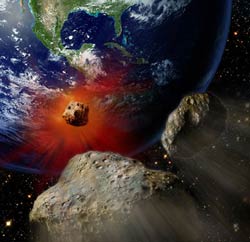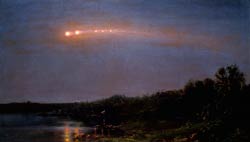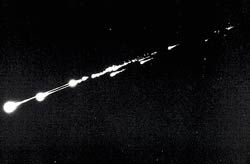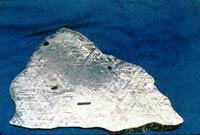 A meteor is the bright streak left behind by a meteoroid that enters the Earth’s atmosphere. Meteors are also known as “shooting stars” or “falling stars.” Now, let’s get technical. A “meteor” refers strictly to the bright streak of light that appears in the sky. The actual objects or particles that enter the atmosphere are known as “meteoroids,” usually pieces of an asteroid that can be as small as a sand grain (100 micrometers) or as large as 10 meters across.
A meteor is the bright streak left behind by a meteoroid that enters the Earth’s atmosphere. Meteors are also known as “shooting stars” or “falling stars.” Now, let’s get technical. A “meteor” refers strictly to the bright streak of light that appears in the sky. The actual objects or particles that enter the atmosphere are known as “meteoroids,” usually pieces of an asteroid that can be as small as a sand grain (100 micrometers) or as large as 10 meters across.
A meteoroid that survives passing through the atmosphere without disintegrating is then called a “meteorite.” Most meteoroids do not survive their journey through the Earth’s atmosphere and disintegrate into very small particles. It is estimated that each day the Earth gains over a thousand ton of mass from the fall of tiny meteorites.
When can meteors be seen?
 Every day millions of small particles enter the Earth’s atmosphere and cause meteors. Most meteors are so brief or small that they go unnoticed. Most meteors can only be seen at night, although some a bright enough to be visible during the day. Small meteors, as small as pebbles, might appear for a second or two before disappearing, while larger ones stay visible longer and sometimes appear brighter as they burn up while disintegrating. A very bright meteor is called a fireball.
Every day millions of small particles enter the Earth’s atmosphere and cause meteors. Most meteors are so brief or small that they go unnoticed. Most meteors can only be seen at night, although some a bright enough to be visible during the day. Small meteors, as small as pebbles, might appear for a second or two before disappearing, while larger ones stay visible longer and sometimes appear brighter as they burn up while disintegrating. A very bright meteor is called a fireball.
A meteor’s altitude is usually within the 75 to 100 kilometer range in the atmosphere, or the Earth’s mesosphere. A meteor is visible to an observer around 65-120 kilometers above the Earth’s surface.
What creates a meteor?
 The bright light that is a meteor is the result of heat produced by a meteoroid’s entry into the atmosphere. The ram pressure, or pressure exerted by the meteoroid moving at high velocities through the atmosphere, generates heat. This pressure then heats the meteorite and the air molecules around it. The surface of the meteoroid reaches high enough temperatures to vaporize some of the atoms and molecules on it as well as atmospheric gases around the meteoroid. These heated, ionized particles form the trail of glowing vapors that we see as a meteor. Meteors appear very briefly because the vaporized gases in the bright streak cool and disperse rather quickly.
The bright light that is a meteor is the result of heat produced by a meteoroid’s entry into the atmosphere. The ram pressure, or pressure exerted by the meteoroid moving at high velocities through the atmosphere, generates heat. This pressure then heats the meteorite and the air molecules around it. The surface of the meteoroid reaches high enough temperatures to vaporize some of the atoms and molecules on it as well as atmospheric gases around the meteoroid. These heated, ionized particles form the trail of glowing vapors that we see as a meteor. Meteors appear very briefly because the vaporized gases in the bright streak cool and disperse rather quickly.
Where do meteoroids come from?
The use of “meteor” to refer to the actual cosmic rocks is actually incorrect and not technical; these celestial objects are actually meteoroids. Where do meteoroids come from? A scientist would tell you they come from asteroids, or some come from comets, and some from the Moon or Mars.
What are meteor showers?
Though millions pass through the Earth each day, throughout the year an unusually large amount of meteors may occur at the same time. This occurrence is known as a meteor shower.  Meteor showers sometimes occur when the Earth passes through remnants of a comet that passed through while orbiting the Sun.
Meteor showers sometimes occur when the Earth passes through remnants of a comet that passed through while orbiting the Sun.
What are meteors made of?
Meteors are made of vaporized and ionized gas trails of meteoroids. Meteoroids and meteorites are made of minerals rich in various compositions of silicon, sodium, copper, potassium, iron, and nickel.
